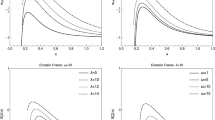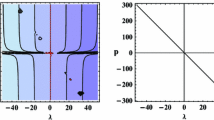Abstract
A Gravitoelectromagnetism formalism in the context of metric f(R) theory is presented and the analogue Lorentz force law is derived. Some interesting results such as the dependence of the deviation from General Relativity (GR) on the absolute value of the scalar potential are found, it is also found that the f(R) effects are only relevant at a shorter distance or when the distance is much less than the compton wavelength, and that the effects are attractive in nature. An investigation of gravitational time delay in the context of metric f(R) is also presented showing that the Ricci scalar alone is responsible for the time delay effect which seems to suggest that the extra scalar degree of freedom associated to f(R) does not provide any modification. Also, to generalise our results, the Lorentz force law and gravitational time delay in the case of Brans–Dicke theories with a potential are derived; it is shown that the results are consistent with those obtained in the case of metric f(R) and GR in the appropriate limits.
Similar content being viewed by others
References
Griffiths, D.J.: Introduction to Electrodynamics. Hall. Prentice Hall, Upper Saddle River (2005)
Newton, I.: Isaac Newton’s Philosophiae Naturalis Principia Mathematica. Harvard University Press, Cambridge (1972)
Holzmuller, G.: Z. Math. Phys. 15, 69 (1870)
Tisserand, F.: Sur le mouvement des planètes autour du soleil, d’après la loi électrodynamique de Weber. Gauthier-Villars, Paris (1872)
Tisserand, F.: Comptes Rendus de l’Académie des Sciences (Paris) 100, 313 (1890)
Thirring, H.: Phys. Z 19, 33 (1918)
Thirring, H.: Physikalische Zeitschrift 19, 156 (1918)
Lense, J., Thirring, H.: Zeitschrift für Physik 19, 156 (1918)
Mashhoon, B., Hehl, F.W., Theiss, D.S.: Nonlinear Gravitodynamics: The Lense-Thirring Effect, pp. 349–388. World Scientific, Singapore (2003)
Ciufolini, I., Wheeler, J.A.: Gravitation and inertia. Princeton University Press, Princeton (1995)
Mashhoon, B., Hehl, F.W., Theiss, D.S.: Gen. Relativ. Gravit. 16(8), 711 (1984)
De Sitter, W.: Mon. Not. R. Astron. Soc. 77, 155 (1916)
Ciufolini, I.: Class. Quantum Grav. 17(12), 2369 (2000)
Mashhoon, B.: Reference Frames and Gravitomagnetism, pp. 121–132. World Scientific, Singapore (2001)
Mashhoon, B., McClune, J.C., Quevedo, H.: Phys. Lett. A 231(1–2), 47 (1997)
Mashhoon, B.: Phys. Lett. A 173(4–5), 347 (1993)
Mashhoon, B.: (2003). arXiv preprint arxiv:gr-qc/0311030
Everitt, C.F., DeBra, D., Parkinson, B., Turneaure, J., Conklin, J., Heifetz, M., Keiser, G., Silbergleit, A., Holmes, T., Kolodziejczak, J., et al.: Phys. Rev. Lett. 106(22), 221101 (2011)
Woodard, R.: The Invisible Universe: Dark Matter and Dark Energy, pp. 403–433. Springer, New York (2007)
Stelle, K.: Phys. Rev. D 16(4), 953 (1977)
Starobinsky, A.A.: Phys. Lett. B 91(1), 99 (1980)
Sotiriou, T.P.: Phys. Rev. D 79(4), 044035 (2009)
Olmo, G.J., Singh, P.: J. Cosmol. Astropart. Phys. 2009(01), 030 (2009)
Sotiriou, T.P., Liberati, S.: Ann. Phys. 322(4), 935 (2007)
Dolgov, A.D., Kawasaki, M.: Phys. Lett. B 573, 1 (2003)
Berry, C.P., Gair, J.R.: Phys. Rev. D 83(10), 104022 (2011)
Capozziello, S., Stabile, A., Troisi, A.: Phys. Rev. D 76(10), 104019 (2007)
Schmidt, H.: Astron. Nachr. 307, 339 (1986)
Teyssandier, P.: Astron. Nachr. 311(4), 209 (1990)
Olmo, G.J.: Phys. Rev. Lett. 95(26), 261102 (2005)
Corda, C.: Int. J. Modern Phys. A 23(10), 1521 (2008)
Weinberg, S.: Gravitation and Cosmology: Principles and Applications of the General Theory of Relativity. Wiley, New York (2014)
Capozziello, S., Corda, C., De Laurentis, M.F.: Phys. Lett. B 669(5), 255 (2008)
Hobson, M.P., Efstathiou, G.P., Lasenby, A.N.: General Relativity: An Introduction for Physicists. Cambridge University Press, Cambridge (2006)
Padmanabhan, T.: Gravitation: Foundations and Frontiers. Cambridge University Press, Cambridge (2010)
Redzic, D.V.: (2013). arXiv preprint arXiv:1303.2567
Bezerra, V., Barros, A., Romero, C.: Braz. J. Phys. 35(4B), 1057 (2005)
Capozziello, S., Cianci, R., De Laurentis, M., Vignolo, S.: Eur. Phys. J. C 70(1–2), 341 (2010)
Prasia, P., Kuriakose, V.: Int. J. Modern Phys. D 23(05), 1450037 (2014)
Ciufolini, I., Kopeikin, S., Mashhoon, B., Ricci, F.: Phys. Lett. A 308(2–3), 101 (2003)
Barros, A., Romero, C.: Modern Phys. Lett. A 18(30), 2117 (2003)
Silva, J.R., Barros, A.: Adv. Stud. Theor. Phys. 9, 787 (2015)
Sotiriou, T.P., Faraoni, V.: Rev. Modern Phys. 82(1), 451 (2010)
Özer, H., Delice, O.: Class. Quantum Gravity 355, 065002 (2018)
Will, C.M.: Theory and Experiment in Gravitational Physics. Cambridge University Press, Cambridge (1993)
Bernabéu, J., Espinoza, C., Mavromatos, N.E.: Phys. Rev. D 81(8), 084002 (2010)
Dass, A., Liberati, S.: https://arxiv.org/abs/1904.07685. Accessed 20 Apr 2019
Acknowledgements
AD would like to thank A. Baldazzi for useful discussions. The authors would like to thank M. Rinaldi for useful feedback. This work was done in SISSA, Italy as part of master’s thesis by AD.
Author information
Authors and Affiliations
Corresponding author
Additional information
Publisher's Note
Springer Nature remains neutral with regard to jurisdictional claims in published maps and institutional affiliations.
Appendix: Evaluation of the potential term
Appendix: Evaluation of the potential term
From (138), we get for the first derivative of \(V(\phi )\) as
and consequently the second derivative of \(V(\phi )\) can be expressed as
Now, using the following quantities which we encountered in the linearised metric f(R) section, i.e,
where \(R^{(1)}\) is the linearised Ricci Scalar. In the subsequent calculation, we drop the suffix (1) and introduce at the end for sake of convenience. Hence, we get the following expression after evaluating for (167)
or
and hence, the expression drops to just
So, if we use the above result, from (141), we have the following expression
Rights and permissions
About this article
Cite this article
Dass, A., Liberati, S. Gravitoelectromagnetism in metric f(R) and Brans–Dicke theories with a potential. Gen Relativ Gravit 51, 84 (2019). https://doi.org/10.1007/s10714-019-2568-4
Received:
Accepted:
Published:
DOI: https://doi.org/10.1007/s10714-019-2568-4




